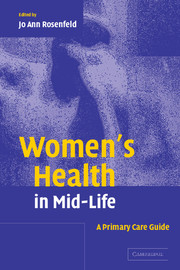Book contents
- Frontmatter
- Contents
- List of contributors
- 1 Introduction
- Part I Health promotion
- Part II Hormonal changes
- Part III Disease prevention
- 12 Prevention of coronary heart disease in women
- 13 Hypertension and stroke
- 14 Diagnosis and treatment of osteoporosis
- 15 Diabetes in mid-life women
- Part IV Cancer prevention
- Index
- References
14 - Diagnosis and treatment of osteoporosis
from Part III - Disease prevention
Published online by Cambridge University Press: 21 August 2009
- Frontmatter
- Contents
- List of contributors
- 1 Introduction
- Part I Health promotion
- Part II Hormonal changes
- Part III Disease prevention
- 12 Prevention of coronary heart disease in women
- 13 Hypertension and stroke
- 14 Diagnosis and treatment of osteoporosis
- 15 Diabetes in mid-life women
- Part IV Cancer prevention
- Index
- References
Summary
Introduction
Osteoporosis is a major public health problem, affecting more than 40 million people, one-third of postmenopausal women, and a substantial portion of the elderly in the USA, Europe, and Japan. An additional 54% of postmenopausal women have low bone density measured at the hip, spine, or wrist. Osteoporosis results in more than 1500000 fractures annually in the USA.
The direct expenditures for osteoporotic fractures have increased during the past decade from $5 billion to approximately $15 billion annually. Of the 25 million women in the USA who have osteoporosis, eight million have a documented fracture. The female-to-male fracture ratios are 7:1 for vertebral fractures, 1.5:1 for distal forearm fractures, and 2:1 for hip fractures. Approximately 70% of hip fractures in individuals older than 65 years of age occur in women. Osteoporosis-related fracture in older men is associated with lower femoral neck bone mineral density (BMD), quadriceps weakness, higher body sway, lower body weight, and decreased stature.
Osteoporotic fractures are more common in white people and Asian people than in African-Americans and Hispanics, and more common in women than in men. Little is known regarding the influence of ethnicity on bone turnover. Factors such as differences in bone accretion are likely to be responsible for much of the ethnic variation in adult BMD.
Prevention
Nutritional prevention
Bone mineralization depends on adequate nutritional status in childhood and adolescence. Therefore, measures to prevent osteoporosis should begin with improving the nutritional status of adolescents to increase bone mineralization, including increasing milk intake.
Keywords
- Type
- Chapter
- Information
- Women's Health in Mid-LifeA Primary Care Guide, pp. 235 - 252Publisher: Cambridge University PressPrint publication year: 2004



